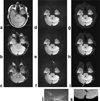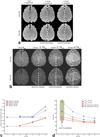Clinical multishot DW-EPI through parallel imaging with considerations of susceptibility, motion, and noise
- PMID: 17457876
- PMCID: PMC3986024
- DOI: 10.1002/mrm.21176
Clinical multishot DW-EPI through parallel imaging with considerations of susceptibility, motion, and noise
Abstract
Geometric distortions and poor image resolution are well known shortcomings of single-shot echo-planar imaging (ss-EPI). Yet, due to the motion immunity of ss-EPI, it remains the most common sequence for diffusion-weighted imaging (DWI). Moreover, both navigated DW interleaved EPI (iEPI) and parallel imaging (PI) methods, such as sensitivity encoding (SENSE) and generalized autocalibrating parallel acquisitions (GRAPPA), can improve the image quality in EPI. In this work, DW-EPI accelerated by PI is proposed as a self-calibrated and unnavigated form of interleaved acquisition. The PI calibration is performed on the b = 0 s/mm2 data and applied to each shot in the rest of the DW data set, followed by magnitude averaging. Central in this study is the comparison of GRAPPA and SENSE in the presence of off-resonances and motion. The results show that GRAPPA is more robust than SENSE against both off-resonance and motion-related artifacts. The SNR efficiency was also investigated, and it is shown that the SNR/scan time ratio is equally high for one- to three-shot high-resolution diffusion scans due to the shortened EPI readout train length. The image quality improvements without SNR efficiency loss, together with motion tolerance, make the GRAPPA-driven DW-EPI sequence clinically attractive.
(c) 2007 Wiley-Liss, Inc.
Figures






References
-
- Ebisu T, Tanaka C, Umeda M, Kitamura M, Naruse S, Higuchi T, Ueda S, Sato H. Discrimination of brain abscess from necrotic or cystic tumors by diffusion-weighted echo planar imaging. Magn Reson Imaging. 1996;14:1113–1116. - PubMed
-
- Kim YJ, Chang KH, Song IC, Kim HD, Seong SO, Kim YH, Han MH. Brain abscess and necrotic or cystic brain tumor: discrimination with signal intensity on diffusion-weighted MR imaging. AJR Am J Roentgenol. 1998;171:1487–1490. - PubMed
-
- Farzaneh F, Riederer SJ, Pelc NJ. Analysis of T2 limitations and off-resonance effects on spatial resolution and artifacts in echo-planar imaging. Magn Reson Med. 1990;14:123–139. - PubMed
Publication types
MeSH terms
Grants and funding
LinkOut - more resources
Full Text Sources
Other Literature Sources
Research Materials
Miscellaneous

